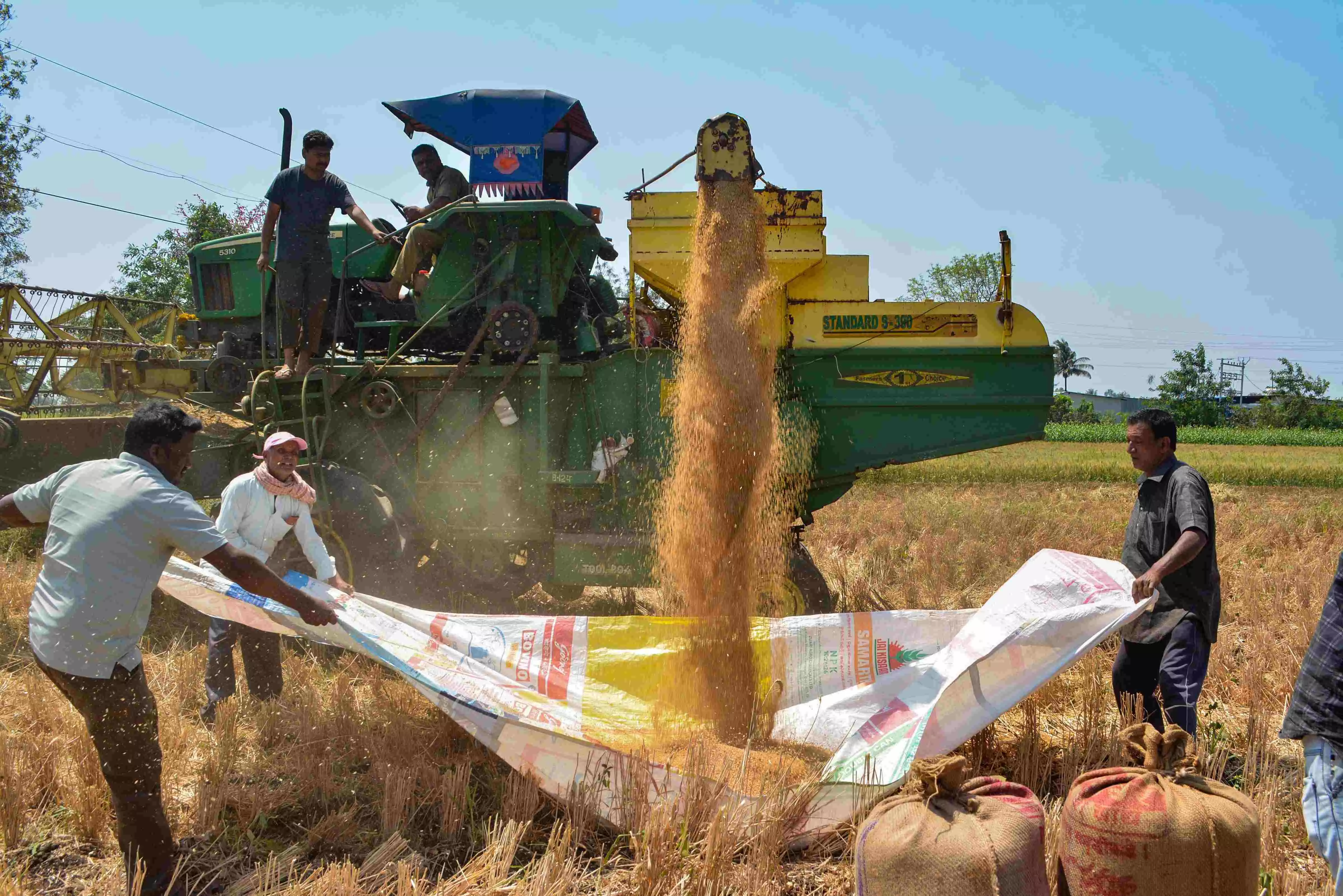Talking Shop: Indian-Canadian Bhai-Bhai
A fast-shrinking Global Village is seeing a common malaise knitting India and Canada together. Back-breaking rise in food prices is seeing eating habits get more frugal each day and farmers in the two nations are taking to the streets

“The human capacity for
burden is like bamboo—
it is far more flexible
than you would ever
believe at first glance.”
—Jodi Picoult
Jasdev Singh Bhullar longed for the fields of Bathinda, reminiscing about the days he and his fellow naughti-zen 15-somethings would pluck kinnoos (orange’s elder brother) right off the shrub and chomp on them while being chased by the baghban (orchard sentry). Belching on the aftertaste of the ill-begotten and surreptitious treat, Punjab’s budding generation would then head for a new hunting ground. Litchis? Amrood? Or plain gannas? Bhullar sighed as he entered a vast gangway at a Toronto Costco, longingly gazing at the oranges that were there just for the seeing; for, at $7 a pop, they were out of his reach, as elusive as the bucolic fields of Punjab.
If we speak geography, all of 8,000 miles separate India and Canada. Intrinsically, so do myriad social issues, societal outlook and aspirational ability. But the fast-shrinking Global Village has seen some common threads knit the two together like never before. One, and hitherto thought impossible and unthinkable, today’s back-breaking rise in food prices is seeing dinner plates (d)evolving and getting more frugal with each passing day. Two, farmers in both nations are taking to the streets, seeking relief and intervention that they say they cannot sustain without anymore. In a bizarre turn of coincidence, farming communities in both nations are up in arms as their backs are pushed tighter against the wall. More bizarre is the fact that the UK has been roped in to help with legislation to curb empty pockets and stomachs.
If oranges are tough…
As Jodi Picoult says in her quote above, being flexible is good, but she doesn’t really mean it in a good way. Bending over backwards is never good, for sooner rather than later, the snapping point is inevitably reached, either cutting people in half or pushing them so far over the edge that they resort to some cutting action of their own—either way, that can never portend (or end) well. Thus, we discuss this today, for that jagged precipice has well-nigh been reached; in India, Canada, much of Europe and other parts of the world. Look at Canada, caught in such a food pincer that a Parliamentary Committee called meetings with retailers to manage runaway food inflation. Among the attendees were representatives from Loblaws, Sobeys and Metro, the top three Canadian retail chains that handle 90 per cent of the country’s foodstuff sales.
To understand what India could be heading for, let’s focus on Canada to see what is transpiring. High food prices are a reality, with costs passed on by food processing companies to consumers. When prices fall at the procurement end, retailers hang on to the difference, fattening profits even as dinner tables present a barren look. Canada’s few retail chains are holding the country price-hostage—resultantly, their CEOs are in the hotseat as an angry public seeks answers. “Food inflation is not happening and what people are saying is simply not true,” retail company CEOs said at a public hearing in Ottawa. Government numbers were startlingly divergent—post-pandemic Canada saw 40-per cent inflation, with food inflation figures higher still.
New wild-wild West?
“I call it the Wild-Wild West, for anything goes pretty much and retailers take advantage,” says Alexis Dodd, former employee with Canadian retailer Northwest, now an activist devoted to feeding the elderly. Fourth-generation farmer Lesley Coley gets 7-15 cents on a loaf of bread sold by retail chains, which bank $6 per loaf. “I’d like to see more so I can feed my family,” she says. Economist James Stanford concurs, saying retail chain’s CEOs’ claims are “laughable”. “Supermarkets have hung on to higher profits and seen bottom-lines double since COVID-19,” he adds. Pre-pandemic Canada saw retail chains gross $2.4 billion in profits; post-pandemic, that number has shot up to over $6 billion (1 Canadian dollar = INR 61.17).
India lacks as much in food equilibrium, and right at the beginning of the procurement chain—farmers themselves. Two years after agitating on the Capital’s borders for 378 days seeking MSP and loan waivers, etc., India’s farmers are back as their demands have not been met ‘despite assurances’. This time around, they have been ‘manning and blocking’ North India’s highways for a month. By the way, the average farmer earns Rs 30 per day, even as big-ticket processing companies using his produce to make packaged foodstuffs rake in profits by the bushel-loads.
The numbers are as benumbing as they are fascinating from a business perspective. Farmers sell 1 kg of cauliflower for Re 1; the end-consumer pays an average of Rs 30. Farmers net Rs 4 for 1 kg of colocasia; the end-consumer pays Rs 120 or more. The mirthless joke going around now is that farmers can afford to eat garlic, French beans and onions, food commodities not affordable in the average Indian household. How do farmers do it? Well, they retain 25 per cent of their produce for personal consumption and barter some for other foodstuffs.
Where we are headed…
…is apparently a very dark place, and that’s summed up tellingly by Jarnail Singh, a farmer sitting at the Punjab-Haryana border in Shambhu. “No matter how much falls on us, we keep ploughing ahead. That’s the only way to keep the roads clear,” he says. It is a cause for despondency that Indian and Canada, still the granaries of the world, are facing food anxiety in their own land. We have focussed on these two nations, but the fact is that global hunger has soared amid the COVID-19 pandemic, Climate Change, conflicts and economic disruptions.
Quick remedial steps are needed before a fiercer food crisis volcano erupts. Some scoff at the new-found term ‘food crisis’. For them, this vignette—globally, a billion people go to bed hungry every night, while the number of people facing acute food insecurity has nearly trebled since 2019 to 345 million people today. “Faced with global crises, global solutions are needed,” the UN said. A starting point could be to onboard food processing firms and retailers. Name them, blame them, tame them or fame them—whatever it takes. No one wants to target enterprise and more power to them, but not at the cost of millions going hungry or committing suicide.
This is perhaps an appropriate time to remember what Yasmin Mogahed said: “Resilience is very different than being numb. Resilience means you experience, you feel, you fail, you hurt. You fall. But you keep going…” Indeed, it is resilience, feeling, falling and still going on that is keeping countries like India and Canada breathing in these lean times. For those who want to migrate (run away) to ‘Kaneda’, here’s a chilling number—Canada has 2.5 million more mouths to feed since the pandemic, but grocery sales are 25 per cent lower than before. That’s not much cud to chew on, is it? This holds true especially for Bhullar, Coley, Dodd, Jarnail and countless Indians and Canadians, with ‘cud’ being the operative term.
The writer is a veteran journalist and communications specialist. He can be reached on [email protected]. Views expressed are personal



